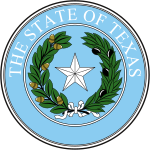This article needs additional citations for verification. (February 2023) |
| Elections in Texas |
|---|
 |
|
|
From 1836 to 1845, the Republic of Texas elected its own presidents. In 1845, it was admitted to the United States as the state of Texas, and has been a participant in every presidential election since, except for 1864 and 1868. Texas did not participate in these due to its secession from the United States to join the Confederate States of America on February 1, 1861, and its status as an unreconstructed state in 1868 following the American Civil War.[1]
Texas gubernatorial elections, as well as other state office races, are held every four years on the nationwide Election Day, which is the Tuesday after the first Monday in November. They are held on years that are even-numbered, but not multiples of four, also known as a midterm, so they do not coincide with the presidential elections. Texas Senate elections for half of the chamber are held every two years on Election Day, with all of the chamber up for election on cycles after major redistricting takes place. Texas House elections are held every two years on Election Day.
For about a hundred years, from after Reconstruction until the 1990s, the Democratic Party dominated Texas politics, making part of the Solid South. In a reversal of alignments, since the late 1960s, the Republican Party has grown more prominent. By the 1990s, it became the state's dominant political party and remains so to this day, as Democrats have not won a statewide race since the 1994 Lieutenant gubernatorial election. Texas is a majority Republican state with Republicans controlling every statewide office.[2] Texas Republicans have majorities in the State House and Senate, an entirely Republican Texas Supreme Court, control of both Senate seats in the US Congress. Texas is America's most-populous Republican state.[3] Many commentators had suggested that Texas is trending Democratic since 2016, however, Republicans have continued to win every statewide office, albeit by reduced margins, as it was the third-closest state Republicans won in 2020.
Texas was the first state to elect a woman governor, simultaneous to Wyoming in 1924 with the election of Miriam A. Ferguson.
In a 2020 study, Texas was ranked as the hardest state for citizens to vote in.[4]
- ^ "Texas secedes from the Union, Feb. 1, 1861". POLITICO. February 2018. Retrieved 2023-02-02.
- ^ "GOP's Abbott wins 3rd term as Texas governor, beats O'Rourke". Associated Press. 8 November 2022.
- ^ "Texas is Entering Third Decade of Republican Control". 23 November 2022.
- ^ J. Pomante II, Michael; Li, Quan (15 Dec 2020). "Cost of Voting in the American States: 2020". Election Law Journal: Rules, Politics, and Policy. 19 (4): 503–509. doi:10.1089/elj.2020.0666. S2CID 225139517. Retrieved 14 January 2022.